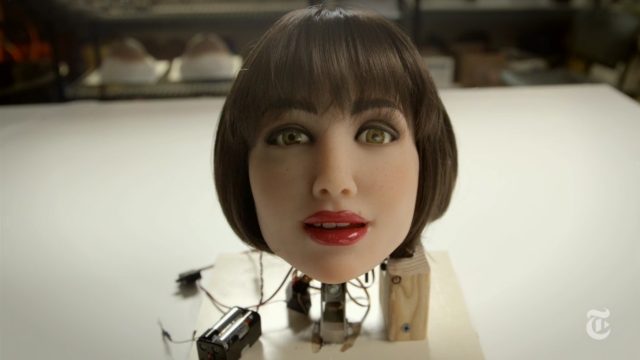
RealDoll, after almost 20 years of selling "the world's finest love doll," is developing an animated, robotic, artificially intelligent head that can be switched onto existing RealDoll bodies. The purpose, according to RealDoll's founder and CEO Matt McMullen, is to "arouse someone on an emotional, intellectual level, beyond the physical."
If you haven't heard of RealDoll before, the company makes expensive ($5,000-$10,000, £3,200-£6,400) but very realistic sex dolls. The dolls (which come in male and female varieties) have fully poseable skeletons, silicone skin, and are roughly the same weight and size as a real human. The dolls have interchangeable faces and orifices.
While the dolls are poseable, they are completely static; they don't move on their own accord, and they don't interact. Clearly this hasn't affected their popularity too much—McMullen says he has sold over 5,000 dolls since 1996—but in any case, he's decided it's now time to take things to the next level.
According to a piece in The New York Times, McMullen has picked up some robotics talent from Hanson Robotics, a company that makes lifelike animatronic heads. On top of that, there's a team working on artificial intelligence—and if that wasn't enough, RealDoll is working on a companion app and an Oculus Rift interface, so that you can interact with your doll's AI when you're away from home.
This video is not safe for work: it has lots of silicone nudity
In the video, McMullen talks about the difficulty, but also the potentially huge reward of developing a realistic sex doll. "The AI, the customisable programming of personality. What is she saying to me? Is she enjoying this? ... If you can create that illusion, that experience, then that's going to be a much more impressive pay-off." Later, he stresses the difficulties of making an AI that doesn't get easily confused or say stupid things, because that "could ruin the whole build-up ... You want to have that illusion that she's actually talking to you. That she's got sentience. That's what's overwhelms me. That's what takes the longest."
As someone that has been working on realistic dolls for 20-odd years, McMullen is aware of the uncanny valley, too, and he has a plan to ensure that his new animated dolls don't fall into it. "You can look at even the best of my dolls, and you can still tell that it's a doll. And I want to keep in that arena ... If you keep it far enough away from super-realism, I think you're in safer territory."
McMullen says the robotic, AI-driven heads—dubbed Realbotix—will be commercially available in two years, priced at around $10,000 (£6,400). If you have an existing RealDoll, you'll be able to swap the new head onto it. After that, RealDoll will begin work on a full-body version, priced somewhere between $30,000 and $60,000 (£19,000 and £38,000). McMullen didn't say how many years we'd have to wait for that, though.

Obviously, the big question about Realbotix is whether it will actually improve the realism of a love doll, or whether it does the exact opposite and breaks the fantasy. Years ago, RealDoll offered some dolls with speech feedback and robotic hip actuators, but they have since been retired, presumably because they detracted from the experience.
"I want people to actually develop an emotional attachment to not only the doll, but to the actual character behind it. To develop some kind of love for this being," McMullen told The New York Times. With the big advances in computer chips, materials, and artificial intelligence over the last few years, it's not completely infeasible that Realbotix will be capable of somewhat intelligent conversation by 2017, and perhaps inspiring the formation of emotional attachments—but McMullen's hope of sentience is probably still a little ways off.
Incidentally, if you haven't seen Ex Machina yet, you really should; it's good!
Listing image by New York Times / RealDoll
reader comments
172